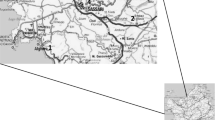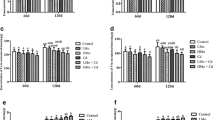Abstract
The aim of this paper was to determine the level of five elements, two essential for life [zinc (Zn) and copper (Cu)] and three distinctly toxic [lead (Pb), cadmium (Cd), and mercury (Hg)], in four types of biological material in bones of the dog Canis lupus familiaris. The experiment was carried out on bones from the hip joints of dogs. The samples of cartilage, compact bone, spongy bone, and cartilage with adjacent compact bone came from 26 domestic dogs from northwestern Poland. Concentrations of Cu, Zn, Pb, and Cd were determined by ICP-AES (atomic absorption spectrophotometry) in inductively coupled argon plasma, using a Perkin-Elmer Optima 2000 DV. Determination of Hg concentration was performed by atomic absorption spectroscopy. In the examined bone material from the dog, the greatest concentrations (median) were observed for Zn and the lowest for Hg (98 mg Zn/kg and 0.0015 mg Hg/kg dw, respectively). In cartilage and spongy bone, metal concentrations could be arranged in the following descending order: Zn > Pb > Cu > Cd > Hg. In compact bone, the order was slightly different: Zn > Pb > Cd > Cu > Hg (from median 70 mg/kg dw to 0.002 mg/kg dw). The comparisons of metal concentrations between the examined bone materials showed distinct differences only in relation to Hg: between concentrations in spongy bone, compact bone, and in cartilage, being greater in cartilage than in compact bone, and lower again in spongy bone.

Similar content being viewed by others
References
UNEP (2002) Global Mercury Assessment. UNEP Chemicals, Geneva, pp 1–270
Agency for Toxic Substances and Disease Registry (ATSDR) (2009) Toxicological profile for lead. US Department of Health and Human Services, Public Health Service, Atlanta
Tulasi SJ, Reddy PUM, Romana Rao JV (1992) Accumulation of lead and effects on total lipids and lipid derivatives in the freshwater fish Anabas testudineus (Bloch). Ecotoxicol Env Safe 23:33–38
Driscoll CT, Evers KF, Lambert KF, Kamman N, Holsen T, Han YJ, Chen C, Goodale W, Butler T, Clair T, Munson R (2007) Mercury matters: linking mercury science with public policy in the northeastern United States. Hubbard Brook Res Found Sci Links Publ 1:1–24
Kalisinska E, Lisowski P, Salicki W, Kavetska K, Kucharska T (2009) Mercury wild terrestrial carnivorous mammals from north-western Poland and unusual fish diet of red fox. Act Theriol 54:345–356
Kalisinska E, Lisowski P, Jackowski A (2010) Mercury in muscle of mallard Anas platyrhynchos living near the city of Szczecin, Poland. Oceanol Hydrobiol Stud suppl 1:79–92
Brodziak-Dopierala B, Kwapulinski J (2007) Influence of smoking tobacco on the occurrence metals in some parts and profiles of femur head. Przegl Lek 64:720–722
Kalisinska E, Salicki W, Kavetska KM, Ligocki M (2007) Trace metal concentrations are higher in cartilage than in bones of scaup and pochard wintering in Poland. Sci Total Environ 388:90–103
Kwapulinski J, Miroslawski J, Wiechula D, Jurkiewicz A, Tokarowski A (1995) The femur capitulum as a biomarker of contamination due to indicating lead content in the air by participation of the other metals. Sci Total Environ 175:57–64
Lanocha N, Kalisinska E, Budis H (2010) Comparison of copper and zinc concentrations in cartilage and cancellous bone of dogs from Szczecin and surrounding areas. Analyst for the twenty-first century society VIII Polish Conference on Analytical Chemistry, Krakow,Warsaw, 4–9 July 2010, p. 347
Budis H, Kalisinska E, Lanocha N (2009) Manganese and copper in bone of red fox from Pomerania, Poland. Ecotoxicology in the real world. The First Joint PSE-SETAC Conference on Ecotoxicology, Kraków, 16–19 September 2009, p. 107
Millan J, Mateo R, Taggart MA, Lopez-Bao JV, Viota M, Monsalve L, Camarero PR, Blazquez E, Jimenez B (2008) Levels of heavy metals and metalloids in critically endangered Iberian lynx and other wild carnivores from Southern Spain. Sci Total Environ 399:193–201
Arnhold W, Anke M, Goebel S (2002) The copper, zinc and manganese status in opossum and gray fox. Z Jagdwiss 48:77–86
Brodziak-Dopierala B, Kwapulinski J, Kusz D, Gajda Z, Sobczyk K (2009) Interactions between concentrations of chemical elements in human femoral heads. Arch Environ Contam Toxicol 57:203–210
Jurkiewicz A, Wiechula D, Mrozek S, Nowak R, Słuzalek M (2001) Cadmium concentrations in the femoral head of Upper Silesia citizens. Ortop Traumatol Rehab 3:350–353
Gamberg M, Braune BM (1999) Contaminant residue levels in arctic wolves (Canis lupus) from the Yukon Territory, Canada. Sci Total Environ 244:329–338
Kuo HW, Kuo SM, Chou CH, Lee TC (2000) Determination of 14 elements in Taiwanese bones. Sci Total Environ 255:45–54
Zaichick S, Zaichick V, Karandashev VK, Moskvina IR (2011) The effect of age and gender on 59 trace-element contents in human rib bone investigated by inductively coupled plasma mass spectrometry. Biol Trace Elem Res 143:41–57
Directive 2003/17/EC of the European Parliament and of the Council of 3 March 2003 amending Directive 98/70/EC relating to the quality of petrol and diesel fuels
Directive 98/70/EC of the European Parliament and of the Council of 13 March 1998 relating to the quality of petrol and diesel fuels Directive 93/12/EC
Kucera E (1986) Dogs as indicators of urban lead distribution. Environ Monit Assess 10:51–57
Lanocha N, Kalisinska E, Budis H (2009) Cadmium and lead in femur cartilage of canids from north-western Poland. Ecotoxicology in the real world. Krakow, 16–19 September 2009, p. 111
Acknowledgments
The study was financed as research project no. NN 404 507738 by the Polish Ministry of Education from the resources for the years 2010–2011.
Author information
Authors and Affiliations
Corresponding author
Additional information
Communicated by D. I. Kosik-Bogacka
Rights and permissions
About this article
Cite this article
Lanocha, N., Kalisinska, E., Kosik-Bogacka, D.I. et al. Evaluation of Dog Bones in the Indirect Assessment of Environmental Contamination with Trace Elements. Biol Trace Elem Res 147, 103–112 (2012). https://doi.org/10.1007/s12011-011-9315-3
Received:
Accepted:
Published:
Issue Date:
DOI: https://doi.org/10.1007/s12011-011-9315-3




